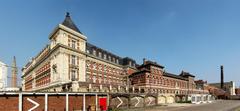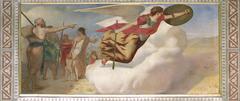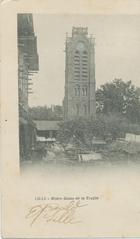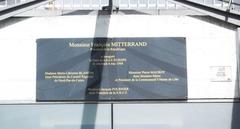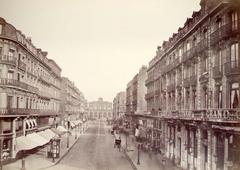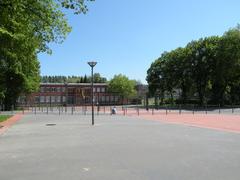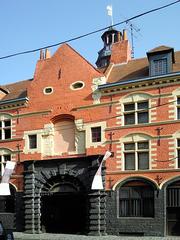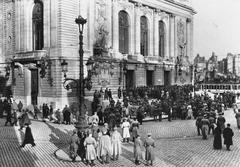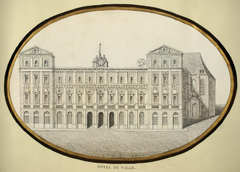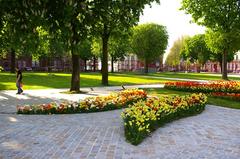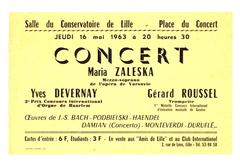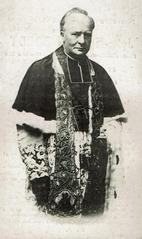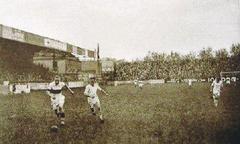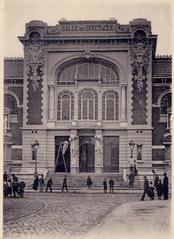Montebello Lille, France: Hours, Tickets, and In-Depth Tourist Guide
Date: 04/07/2025
Introduction: Montebello’s Heritage and Cultural Role
Montebello, in the dynamic southwestern district of Lille, is a destination rich in history, culture, and architectural distinction. This guide provides a comprehensive look at the area’s urban evolution, focusing especially on the transformation of the historic Lycée International Montebello—from its 19th-century origins as a hospital to its current life as a leading educational institution. Whether you are an architecture enthusiast, a history buff, or a traveler seeking authentic experiences, Montebello offers a fascinating window into Lille’s development, multicultural life, and commitment to heritage preservation (Wikiwand, fr.wikipedia).
Montebello’s key artery, Boulevard Montebello, connects diverse neighborhoods and embodies the district’s blend of Flemish and French styles. The area’s adaptive reuse of historical structures, particularly the conversion of the Hôpital Sainte-Eugénie into the Lycée International Montebello, exemplifies Lille’s ongoing efforts to harmonize heritage and urban renewal (Lycée International Montebello, Lille Tourism).
Table of Contents
- Introduction
- Historical Development and Urban Evolution
- Lycée International Montebello: History and Transformation
- Montebello District: Urban Landscape and Key Monuments
- Visiting Hours, Tickets, and Accessibility
- Getting There and Transportation
- Nearby Attractions and Local Life
- Practical Tips for Visitors
- Frequently Asked Questions (FAQ)
- Conclusion
- References
Historical Development and Urban Evolution
Montebello’s origins are intertwined with Lille’s 19th-century industrial expansion. The district, centered around the eponymous boulevard, rose to prominence with the construction of the Hôpital Sainte-Eugénie in 1859—a response to the city’s urgent healthcare needs. Designed by August Mourcou and completed in 1873, the hospital introduced advanced medical architecture, emphasizing ventilation, natural light, and patient well-being (Wikiwand).
By the early 20th century, shifts in healthcare and urban priorities led to the conversion of the underutilized hospital into an educational institution. Architect Mitrofanoff’s 1921 redesign preserved the building’s historic character, setting a precedent for adaptive reuse in Lille (fr.wikipedia).
Lycée International Montebello: History and Transformation
Foundation and Architectural Significance
The former hospital buildings were repurposed as Lycée Européen Montebello in 1992, later renamed Lycée International Montebello in 2014 to highlight its global orientation. The campus merges 19th-century brick-and-stone facades, large windows, and spacious courtyards with modern educational amenities, symbolizing Lille’s dedication to architectural preservation (Wikiwand, en.wikipedia).
International Academic Focus and Reputation
Lycée International Montebello serves around 1,400 students and offers a range of academic tracks, including the French Baccalauréat and specialized technological programs. Its strong international dimension is reflected in language offerings (English, Spanish, and German), the Bac Français International, and ERASMUS+ partnerships that facilitate student exchanges and internships abroad (letudiant.fr, parcoursup.fr).
The school boasts a high pass rate in the baccalauréat (96% in 2024) and is selective in its competitive BTS Commerce International program (college-lycee.com).
Student Life and Facilities
The campus features a harmonious blend of historic and contemporary buildings, including rare urban boarding facilities, language and cultural clubs, and extracurricular activities. This environment fosters a sense of inclusion and diversity (Wikiwand).
Montebello District: Urban Landscape and Key Monuments
Montebello’s urban landscape is characterized by tree-lined boulevards, diverse 19th- and 20th-century architecture, and proximity to major heritage sites.
Notable Highlights
- Boulevard Montebello: The district’s central thoroughfare, showcasing a mix of Romanesque, Neo-Renaissance, and Art Nouveau facades.
- Vauban Citadel: A 17th-century military fortress and Lille’s largest green space, accessible from Montebello and hosting cultural events (planetware.com).
- Parc de la Citadelle: Ideal for walks, picnics, and outdoor activities.
- Marché de Wazemmes: A vibrant market reflecting Lille’s multicultural spirit.
- Maison Folie Wazemmes: A hub for art exhibitions and community events (en.lilletourism.com).
Visiting Hours, Tickets, and Accessibility
Lycée International Montebello
- General Access: The school operates as an active educational institution; public access to the interior is restricted except during special events such as European Heritage Days or official open houses (Lycée International Montebello).
- Exterior Viewing: The historic exterior and landscaped grounds can be admired from public areas at any time.
- Tickets: Entry is free during open events; otherwise, visits are by appointment only.
- Guided Tours: Available during heritage events, offering insights into the site’s history and architecture.
Vauban Citadel
- Park Hours: Open daily from 8:00 AM to 8:00 PM. Guided tours are offered seasonally; check Lille Tourism for updates.
- Entry Fees: Park access is free; some guided tours and exhibitions may require tickets (€5–€10).
Accessibility
Both the lycée’s modern facilities and the main park areas at the Citadel are wheelchair accessible. For specific needs, contact the school or event organizers ahead of your visit.
Getting There and Transportation
Montebello is conveniently accessible:
- Metro: Line 1 (Montebello station); Line 2 (Cormontaigne, Porte des Postes).
- Bus: Multiple lines serve the district; see Lille Tourism Transport Guide.
- Cycling: Lille’s V’Lille bike-sharing system and bike lanes are available.
- From Train Stations: Lille-Flandres and Lille-Europe are under 15 minutes away by metro.
Parking is available at nearby lots such as Parking République and Parking Porte des Postes. Electric scooters and bike rentals are widely available.
Nearby Attractions and Local Life
Montebello’s strategic location enables easy exploration of Lille’s cultural and historic highlights:
- Vieux Lille (Old Town): Cobblestone streets, Renaissance and Flemish architecture, lively squares (CK Travels Lille Guide).
- Grand Place: The heart of Lille’s social and architectural life.
- Palais des Beaux-Arts: One of France’s premier fine arts museums.
- Parc Jean-Baptiste Lebas: A popular green space nearby.
Local life thrives at the Wazemmes Market, Maison Folie for cultural events, and in the neighborhood’s estaminets and bistros showcasing northern French and international cuisine (Travel France Bucket List).
Practical Tips for Visitors
- Best Time to Visit: Spring (April–June) and autumn (September–October) offer pleasant weather and vibrant festivals (Best Time to Visit Lille).
- Language: Basic French is appreciated, though English is widely understood in tourist areas.
- Safety: The district is generally safe, but take standard urban precautions, especially during busy market days or at night.
- Connectivity: Free Wi-Fi is available in many cafes; local SIM cards or eSIMs ensure reliable mobile data (Happy to Wander France Tips).
- Sustainability: Use public transportation, support local markets, and bring reusable bags and water bottles.
Frequently Asked Questions (FAQ)
Q: Can I visit inside the Lycée International Montebello?
A: Public interior visits are generally limited to special events or by appointment. The exterior and grounds are visible from public spaces.
Q: Are there entrance fees for the Citadel or Montebello landmarks?
A: Access to Parc de la Citadelle is free. Some guided tours may require tickets.
Q: Is Montebello accessible for visitors with mobility issues?
A: Yes, public areas and metro stations are accessible, though some historic buildings may have limited access.
Q: How do I reach Montebello from Lille’s city center?
A: Take Metro Line 1 to Montebello or Line 2 to Cormontaigne/Porte des Postes; buses and bike-sharing are also available.
Q: Are there guided tours?
A: Guided tours are available during heritage events at the lycée and regularly at the Citadel; check Lille Tourism for schedules.
Conclusion
Montebello, Lille, is a vibrant district where historical architecture, educational innovation, and multicultural urban life intersect. Its iconic lycée, green spaces, bustling markets, and excellent connectivity make it a rewarding destination for visitors seeking an authentic Lille experience. Use this guide and the referenced resources to plan a seamless, enriching visit—whether you’re exploring architectural gems, enjoying local cuisine, or delving into the city’s dynamic community spirit.
For real-time updates, event schedules, and self-guided tours, visit the official Lycée International Montebello website and the Lille Tourism portal. Enhance your stay with the Audiala app for interactive maps and personalized recommendations.
References
- Wikiwand: Lycée International Montebello
- fr.wikipedia: Lycée International Montebello
- en.wikipedia: Lycée International Montebello
- Lille Tourism Official Website
- Lycée International Montebello Official Website
